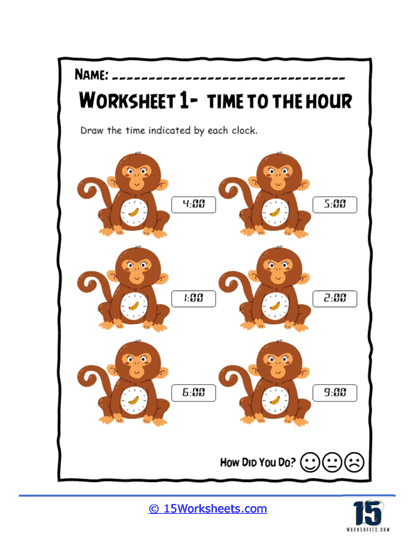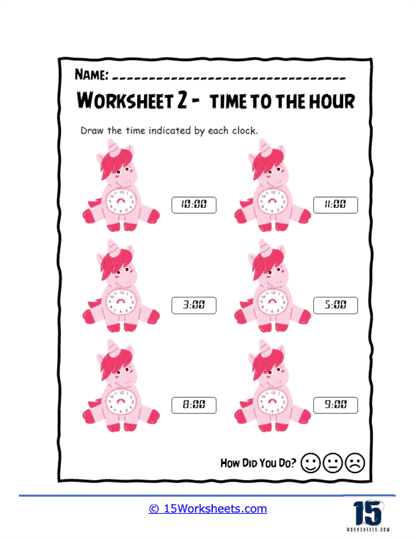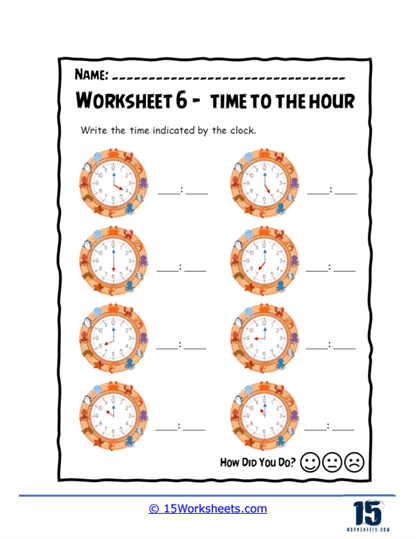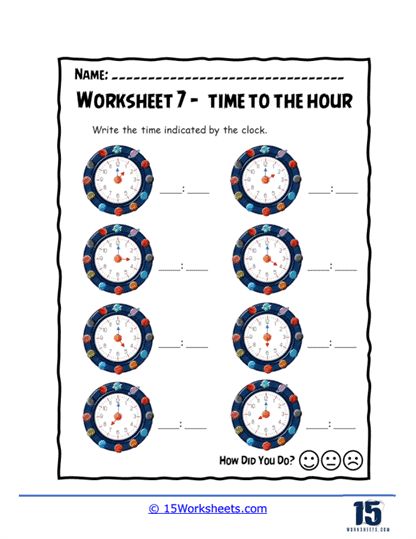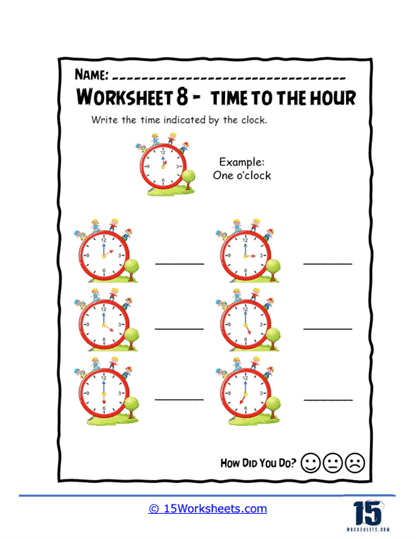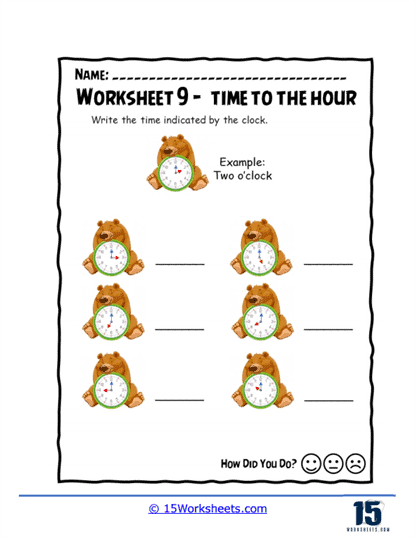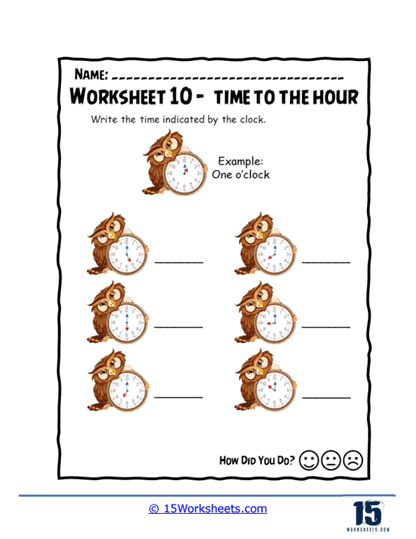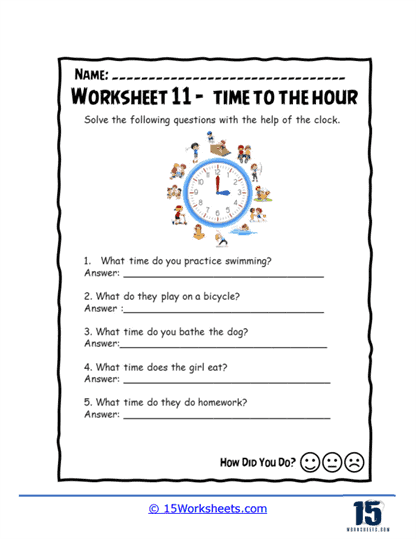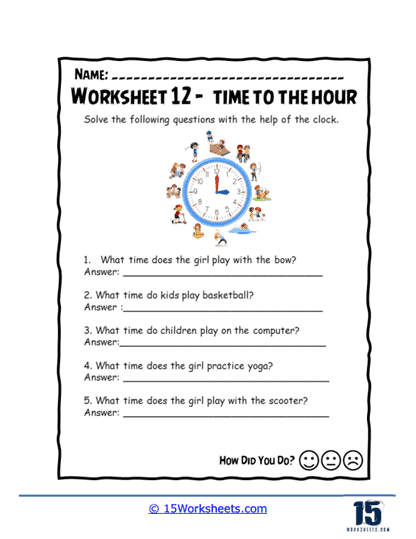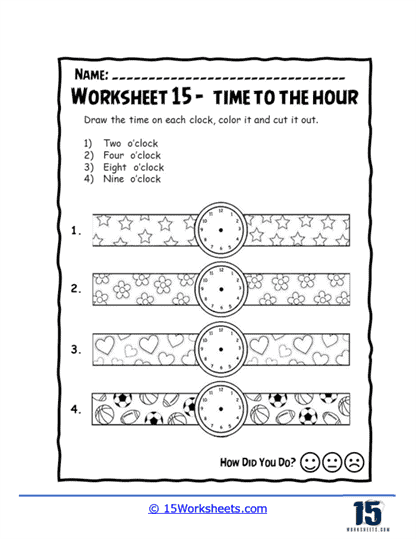Time to the Hour Worksheets
About These 15 Worksheets
These worksheets help young learners grasp the fundamental concept of telling time. These worksheets focus on teaching students how to read clocks, specifically when the time is on the hour, such as 1:00, 2:00, or 3:00. Understanding time is a critical skill that not only helps students in their daily lives but also forms a foundation for more advanced time-related concepts they will encounter later in their education.
These worksheets typically feature analog clocks, where students are required to read the position of the hour and minute hands and determine the correct time. The emphasis is on recognizing when the minute hand points to the 12, which signifies the top of the hour, and the hour hand points to the respective hour. Through repeated practice, students develop the ability to quickly and accurately tell the time, a skill that is essential for their academic growth and practical life.
Benefits of These Worksheets
These worksheets offer numerous benefits for young learners. Firstly, they enhance students’ ability to understand and interpret the passage of time, a critical life skill. By regularly practicing with these worksheets, students become proficient in reading clocks, which is a necessary skill for managing daily activities and routines. Additionally, these worksheets help students improve their fine motor skills as they practice drawing the hands on clocks or writing the correct time.
The worksheets support cognitive development by encouraging logical thinking and problem-solving. As students work through different exercises, they learn to recognize patterns and make connections between the positions of the clock hands and the time displayed. This not only aids in time-telling but also enhances their overall mathematical thinking.
They are adaptable for various learning environments, making them suitable for both classroom and home use. Teachers and parents can use these worksheets to provide additional practice for students who may need extra support or to challenge those who have already grasped the basic concept of telling time.
Math Skills Explored
The worksheets explore several key math skills that are essential for young learners. One of the primary skills is number recognition and counting. Students must be able to identify the numbers on the clock face and understand their sequence. This reinforces their counting abilities and helps them become familiar with the numerical order from 1 to 12.
Another critical math skill is the concept of intervals and units of time. Students learn that each hour is divided into 60 minutes and that the minute hand’s position at the 12 signifies the beginning of a new hour. This understanding of time intervals is foundational for more advanced time-telling skills, such as reading half-hour and quarter-hour increments.
These worksheets encourage spatial awareness and the ability to interpret visual information. Students must recognize the relative positions of the hour and minute hands on the clock and translate that visual information into a numerical time. This skill is crucial for developing the ability to read various types of graphs and charts later in their education.
Exercises on These Worksheets
These worksheets are designed to introduce and reinforce the fundamental skill of reading and interpreting clocks, specifically focusing on recognizing and understanding whole hours. These worksheets typically begin with basic exercises where students are presented with blank clock faces and are asked to draw the hands to indicate specific times on the hour. For instance, a worksheet might ask students to draw the hands showing 3:00 or 8:00. This exercise helps students understand the correct positions for the hour and minute hands and reinforces the concept that the minute hand points to the 12 when indicating the top of the hour.
Another common type of problem involves reading clock faces and writing down the time shown. In these exercises, students are given clock faces with the hands already drawn to the nearest hour, and they must identify and write the corresponding time. For example, a clock might show the hour hand pointing to the 5 and the minute hand at the 12, and students would need to write “5:00”. These problems help students practice recognizing and interpreting the positions of the hands and associating them with specific times.
The worksheets also include matching exercises, where students are given a series of clock faces showing different times and a list of written times. They must match each clock face to the correct written time. This type of exercise reinforces the connection between visual and written representations of time and helps solidify their understanding of telling time to the hour.
In addition to these fundamental exercises, some worksheets incorporate real-life scenarios and word problems to provide context for time-telling skills. For example, a problem might describe a daily routine, such as “Breakfast is at 7:00 AM, school starts at 8:00 AM, and bedtime is at 8:00 PM.” Students would then be asked to draw the appropriate times on blank clock faces or identify the times shown on provided clocks. These problems help students see the practical application of telling time and understand how it fits into daily activities.
Sequencing exercises are another type of problem that might be found on these worksheets. Students are given a series of events with their times listed (e.g., “Wake up at 7:00 AM, lunch at 12:00 PM, dinner at 6:00 PM”) and must put them in the correct order. These exercises help students understand the chronological flow of time and improve their ability to organize and sequence events.

